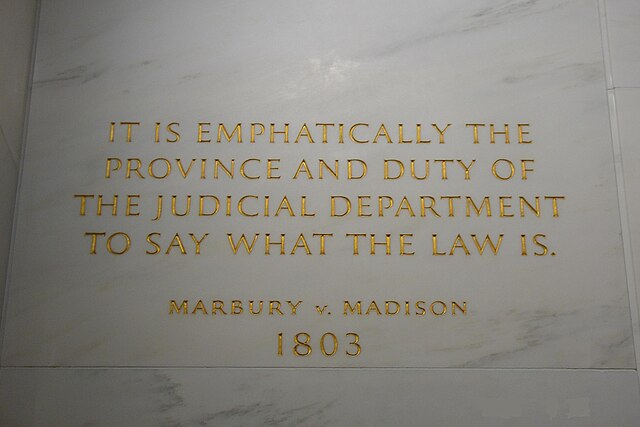From elementary school social studies through middle and high school American History to United States Government class, the content and structure of our Constitution is one of those few school subjects that gets (understandably) repeated, over and over, throughout the course of a typical student’s time in primary and secondary school. One of the most basic elements of that unit is how the checks and balances of our system of government work and, memorably, how the key responsibility of “judicial review” is not actually to be found anywhere in the text of the Constitution. Instead, as the lesson goes, Chief Justice of the Supreme Court John Marshall created this power for the Supreme Court in their ruling on the 1803 landmark case Marbury v. Madison when, as part of his decision, Marshall declared a law previously passed by Congress to be in conflict with Congress’s authority as delineated in the Constitution and thus unconstitutional. In so doing, Marshall staked a claim to a much larger role for the judiciary than the framers had originally intended, at least in their finished product, transforming the US government into a tripartite system where any two other branches of government can theoretically check the third in the case of overreach or incapacity. But how accurate is this traditional picture?
It is true that nowhere in the Constitution does the phrase “judicial review” appear, nor does the document explicitly state that the judicial branch of government, capped by the Supreme Court, has the responsibility of vetting laws’ adherence to the principles set forth therein. In fact, Article III of the Constitution is the shortest of all branch-of-government articles, more concerned with how courts should be set up than how they should actually work. Ironic, then, that Marshall would essentially unconstitutionally invent his own authority to declare laws unconstitutional!
Read another way, however, the concept of judicial review is implicitly baked into the core concept of the Supreme Court and judicial branch in general as outlined by the Constitution. If the legislative branch creates the laws and the executive enforces the laws, then the nature of the judiciary is that it interprets the laws and how they should be applied. The Supreme Court, above other lower courts that Congress can choose to set up, are organized as appellate courts–in other words, they do not try cases initially, but receive them on appeal and rule on whether those cases were tried properly in lower courts and whether relevant laws were applied correctly. If the Constitution is the most basic, primary law of the land, then an appellate court would naturally weigh whether subsequent laws would conflict with that first, overriding framework for how our nation’s legal system works. In this way, judicial review is very much inherent in the Supreme Court’s responsibilities as laid out in the Constitution, even if the phrase is never explicitly used.
Complicating the picture further, though, is the fact that judicial review was so sparingly used in the Early Republic. In fact, Marbury v. Madison was the only occasion in which a law was declared unconstitutional for over fifty years—the next instance was the infamous Dred Scott Decision of 1857 (in which Chief Justice Roger B. Taney erroneously did so using some of the dumbest, most obtuse logical reasoning ever recorded). Any particular reason for this would likely require a full monograph to support, but it likely comes down to some combination of a less centralized Federal government, less powerful judiciary that had to tread carefully lest it be neutered entirely, and generally less developed infrastructure and slower communication to bind small town, rural America together. The effect, though, is a Supreme Court that exercised its ultimate power for the first time and then promptly ignored it for half a century, almost as if it wasn’t a core element of its core Constitutional duties. No wonder judicial review has been such a complicated issue to grasp, teach, and explain over the last two centuries!
